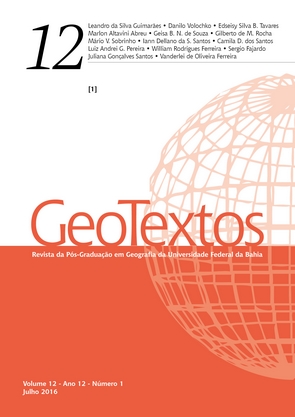MODEL OF BRAZILIAN URBANIZATION: GENERAL NOTES
DOI:
https://doi.org/10.9771/1984-5537geo.v12i1.14084Keywords:
Urbanization, Periphery, Inequality, TerritoryAbstract
The full text format seeks to analyze the social inequality in Brazil through the spatial process of that inequality in this sense it analyzes, scratching the edges of what is known of the Brazilian urbanization model and how this same model produced gentrification cities and exclusive. So search the text discuss the country’s urban exclusion through consolidation of what is conventionally called peripheral areas, or more generally, of peripheries. The text on screen is the result of research carried out at the Federal Fluminense University in Masters level. In this study, we tried to understand the genesis of an urban housing development located in São Gonçalo, Rio de Janeiro called Jardim Catarina. Understand what the problem space partner who originated it. In this sense, his analysis becomes consubstantial to understand the social and spatial inequalities in Brazil, as well as the role of the state as planning manager socio-spatial planning and principal agent in the solution of such problems. It is expected that with the realization of a study of greater amounts, from which this article is just a micro work can contribute subsidies that contribute to the arrangement and crystallization of public policies that give account of social inequalities and serve to leverage a country more fair and equitable cities.Downloads
Downloads
Published
How to Cite
Issue
Section
License
Autores que publicam nesta revista concordam com os seguintes termos:
Autores mantém os direitos autorais e concedem à revista o direito de primeira publicação, com o artigo simultaneamente licenciado sob a Licença Creative Commons Creative Commons CC BY que permite o compartilhamento do trabalho com reconhecimento da autoria e publicação inicial nesta revista. Esta licença permite que outros distribuam, remixem, adaptem e criem a partir do seu trabalho, mesmo para fins comerciais, desde que lhe atribuam o devido crédito pela criação original. É a licença mais flexível de todas as licenças disponíveis. É recomendada para maximizar a disseminação e uso dos materiais licenciados. Ver o resumo da licença em: https://creativecommons.org/licenses/by/4.0/ Ver o texto legal da licença em: https://creativecommons.org/licenses/by/4.0/ Consulte o site do Creative Commons: https://creativecommons.org/licenses/?lang=pt
Autores têm autorização para assumir contratos adicionais separadamente, para distribuição não-exclusiva da versão do trabalho publicada nesta revista (ex.: publicar em repositório institucional ou como capítulo de livro), com reconhecimento de autoria e publicação inicial nesta revista.
Autores têm permissão e são estimulados a publicar e distribuir seu trabalho online (ex.: em repositórios institucionais ou na sua página pessoal) a qualquer ponto antes ou durante o processo editorial, já que isso pode gerar alterações produtivas, bem como aumentar o impacto e a citação do trabalho publicado (Veja O Efeito do Acesso Livre).






